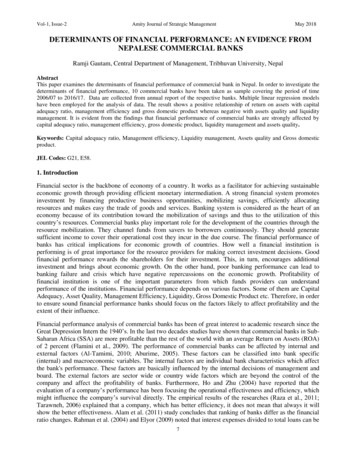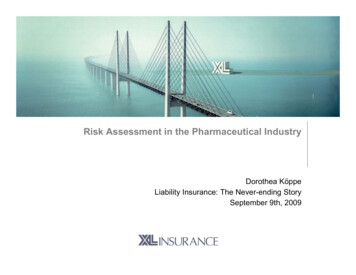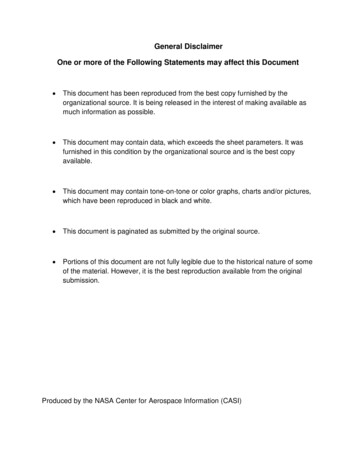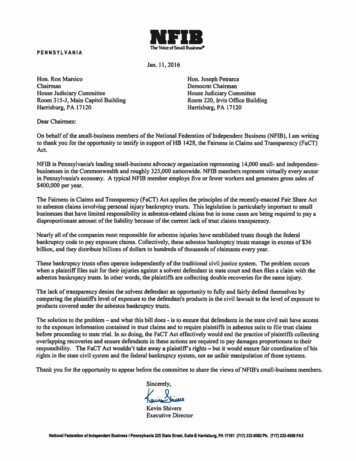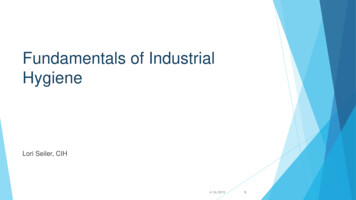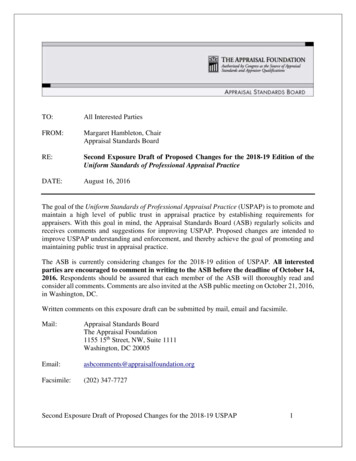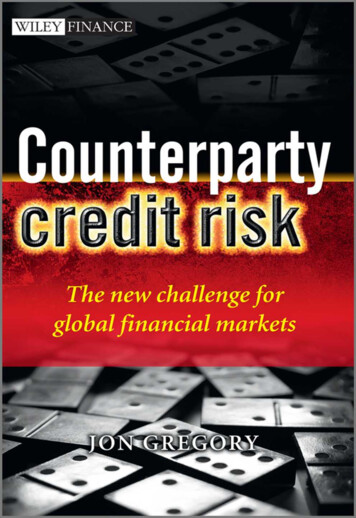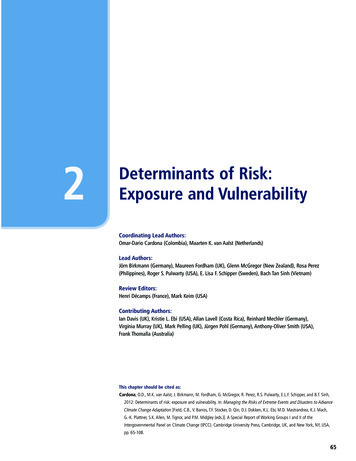
Transcription
2Determinants of Risk:Exposure and VulnerabilityCoordinating Lead Authors:Omar-Dario Cardona (Colombia), Maarten K. van Aalst (Netherlands)Lead Authors:Jörn Birkmann (Germany), Maureen Fordham (UK), Glenn McGregor (New Zealand), Rosa Perez(Philippines), Roger S. Pulwarty (USA), E. Lisa F. Schipper (Sweden), Bach Tan Sinh (Vietnam)Review Editors:Henri Décamps (France), Mark Keim (USA)Contributing Authors:Ian Davis (UK), Kristie L. Ebi (USA), Allan Lavell (Costa Rica), Reinhard Mechler (Germany),Virginia Murray (UK), Mark Pelling (UK), Jürgen Pohl (Germany), Anthony-Oliver Smith (USA),Frank Thomalla (Australia)This chapter should be cited as:Cardona, O.D., M.K. van Aalst, J. Birkmann, M. Fordham, G. McGregor, R. Perez, R.S. Pulwarty, E.L.F. Schipper, and B.T. Sinh,2012: Determinants of risk: exposure and vulnerability. In: Managing the Risks of Extreme Events and Disasters to AdvanceClimate Change Adaptation [Field, C.B., V. Barros, T.F. Stocker, D. Qin, D.J. Dokken, K.L. Ebi, M.D. Mastrandrea, K.J. Mach,G.-K. Plattner, S.K. Allen, M. Tignor, and P.M. Midgley (eds.)]. A Special Report of Working Groups I and II of theIntergovernmental Panel on Climate Change (IPCC). Cambridge University Press, Cambridge, UK, and New York, NY, USA,pp. 65-108.65
Determinants of Risk: Exposure and VulnerabilityChapter 2Table of ContentsExecutive Summary .672.1.Introduction and Scope.692.2.Defining Determinants of Risk: Hazard, Exposure, and Vulnerability .692.2.1.2.2.2.Disaster Risk and Disaster .69The Factors of Risk .692.3.The Drivers of Vulnerability .702.4.Coping and Adaptive Capacities ity and Vulnerability .72Different Capacity Needs .74Capacity to Anticipate Risk.74Capacity to Respond.74Capacity to Recover and Change.75Factors of Capacity: Drivers and Barriers.762.5.Dimensions and Trends of Vulnerability and Exposure .5.4.2.2.5.4.3.Environmental Dimensions.76Physical Dimensions .77Geography, Location, Place .77Settlement Patterns and Development Trajectories.78Social Dimensions .80Demography .80Education.81Health and Well-Being .82Cultural Dimensions.84Institutional and Governance Dimensions .85Economic Dimensions.86Interactions, Cross-Cutting Themes, and Integrations .87Intersectionality and Other Dimensions.88Timing, Spatial, and Functional Scales .88Science and Technology .892.6.Risk Identification and Assessment .892.6.1.2.6.2.2.6.3.Risk Identification .90Vulnerability and Risk Assessment.90Risk Communication.952.7.Risk Accumulation and the Nature of Disasters .95References .9666
Chapter 2Determinants of Risk: Exposure and VulnerabilityExecutive SummaryThe severity of the impacts of extreme and non-extreme weather and climate events depends strongly onthe level of vulnerability and exposure to these events (high confidence). [2.2.1, 2.3, 2.5] Trends in vulnerabilityand exposure are major drivers of changes in disaster risk, and of impacts when risk is realized (high confidence). [2.5]Understanding the multi-faceted nature of vulnerability and exposure is a prerequisite for determining how weatherand climate events contribute to the occurrence of disasters, and for designing and implementing effective adaptationand disaster risk management strategies. [2.2, 2.6]Vulnerability and exposure are dynamic, varying across temporal and spatial scales, and depend on economic,social, geographic, demographic, cultural, institutional, governance, and environmental factors (highconfidence). [2.2, 2.3, 2.5] Individuals and communities are differentially exposed and vulnerable and this is basedon factors such as wealth, education, race/ethnicity/religion, gender, age, class/caste, disability, and health status. [2.5]Lack of resilience and capacity to anticipate, cope with, and adapt to extremes and change are important causal factorsof vulnerability. [2.4]Extreme and non-extreme weather and climate events also affect vulnerability to future extreme events,by modifying the resilience, coping, and adaptive capacity of communities, societies, or social-ecologicalsystems affected by such events (high confidence). [2.4.3] At the far end of the spectrum – low-probability, highintensity events – the intensity of extreme climate and weather events and exposure to them tend to be more pervasivein explaining disaster loss than vulnerability in explaining the level of impact. But for less extreme events – higherprobability, lower intensity – the vulnerability of exposed elements plays an increasingly important role (highconfidence). [2.3] The cumulative effects of small- or medium-scale, recurrent disasters at the sub-national or locallevels can substantially affect livelihood options and resources and the capacity of societies and communities toprepare for and respond to future disasters. [2.2.1, 2.7]High vulnerability and exposure are generally the outcome of skewed development processes, such asthose associated with environmental mismanagement, demographic changes, rapid and unplannedurbanization in hazardous areas, failed governance, and the scarcity of livelihood options for the poor(high confidence). [2.2.2, 2.5]The selection of appropriate vulnerability and risk evaluation approaches depends on the decisionmakingcontext (high confidence). [2.6.1] Vulnerability and risk assessment methods range from global and nationalquantitative assessments to local-scale qualitative participatory approaches. The appropriateness of a specific methoddepends on the adaptation or risk management issue to be addressed, including for instance the time and geographicscale involved, the number and type of actors, and economic and governance aspects. Indicators, indices, andprobabilistic metrics are important measures and techniques for vulnerability and risk analysis. However, quantitativeapproaches for assessing vulnerability need to be complemented with qualitative approaches to capture the fullcomplexity and the various tangible and intangible aspects of vulnerability in its different dimensions. [2.6]Appropriate and timely risk communication is critical for effective adaptation and disaster risk management(high confidence). Effective risk communication is built on risk assessment, and tailored to a specific audience, whichmay range from decisionmakers at various levels of government, to the private sector and the public at large, includinglocal communities and specific social groups. Explicit characterization of uncertainty and complexity strengthens riskcommunication. Impediments to information flows and limited awareness are risk amplifiers. Beliefs, values, andnorms influence risk perceptions, risk awareness, and choice of action. [2.6.3]Adaptation and risk management policies and practices will be more successful if they take the dynamicnature of vulnerability and exposure into account, including the explicit characterization of uncertaintyand complexity at each stage of planning and practice (medium evidence, high agreement). However,approaches to representing such dynamics quantitatively are currently underdeveloped. Projections of the impacts of67
Determinants of Risk: Exposure and VulnerabilityChapter 2climate change can be strengthened by including storylines of changing vulnerability and exposure under differentdevelopment pathways. Appropriate attention to the temporal and spatial dynamics of vulnerability and exposure isparticularly important given that the design and implementation of adaptation and risk management strategies andpolicies can reduce risk in the short term, but may increase vulnerability and exposure over the longer term. Forinstance, dike systems can reduce hazard exposure by offering immediate protection, but also encourage settlementpatterns that may increase risk in the long term. [2.4.2.1, 2.5.4.2, 2.6.2]Vulnerability reduction is a core common element of adaptation and disaster risk management (highconfidence). Vulnerability reduction thus constitutes an important common ground between the two areas of policyand practice. [2.2, 2.3]68
Chapter 22.1.Introduction and ScopeMany climate change adaptation efforts aim to address the implicationsof potential changes in the frequency, intensity, and duration of weatherand climate events that affect the risk of extreme impacts on humansociety. That risk is determined not only by the climate and weatherevents (the hazards) but also by the exposure and vulnerability to thesehazards. Therefore, effective adaptation and disaster risk managementstrategies and practices also depend on a rigorous understanding of thedimensions of exposure and vulnerability, as well as a proper assessmentof changes in those dimensions. This chapter aims to provide thatunderstanding and assessment, by further detailing the determinants ofrisk as presented in Chapter 1.The first sections of this chapter elucidate the concepts that are neededto define and understand risk, and show that risk originates from acombination of social processes and their interaction with the environment(Sections 2.2 and 2.3), and highlight the role of coping and adaptivecapacities (Section 2.4). The following section (2.5) describes the differentdimensions of vulnerability and exposure as well as trends therein.Given that exposure and vulnerability are highly context-specific, thissection is by definition limited to a general overview (a more quantitativeperspective on trends is provided in Chapter 4). A methodologicaldiscussion (Section 2.6) of approaches to identify and assess risk providesindications of how the dimensions of exposure and vulnerability can beexplored in specific contexts, such as adaptation planning, and thecentral role of risk perception and risk communication. The chapterconcludes with a cross-cutting discussion of risk accumulation and thenature of disasters (Section 2.7).2.2.Defining Determinants of Risk:Hazard, Exposure, and Vulnerability2.2.1.Disaster Risk and DisasterDisaster risk signifies the possibility of adverse effects in the future. Itderives from the interaction of social and environmental processes, fromthe combination of physical hazards and the vulnerabilities of exposedelements (see Chapter 1). The hazard event is not the sole driver of risk,and there is high confidence that the levels of adverse effects are ingood part determined by the vulnerability and exposure of societies andsocial-ecological systems (UNDRO, 1980; Cuny, 1984; Cardona, 1986,1993, 2011; Davis and Wall, 1992; UNISDR, 2004, 2009b; Birkmann,2006a,b; van Aalst 2006a).Disaster risk is not fixed but is a continuum in constant evolution. Adisaster is one of its many ‘moments’ (ICSU-LAC, 2010a,b), signifyingunmanaged risks that often serve to highlight skewed developmentproblems (Westgate and O’Keefe, 1976; Wijkman and Timberlake, 1984).Disasters may also be seen as the materialization of risk and signify ‘abecoming real’ of this latent condition that is in itself a social construction(see below; Renn, 1992; Adam and Van Loon, 2000; Beck, 2000, 2008).Determinants of Risk: Exposure and VulnerabilityDisaster risk is associated with differing levels and types of adverseeffects. The effects may assume catastrophic levels or levels commensuratewith small disasters. Some have limited financial costs but very highhuman costs in terms of loss of life and numbers of people affected;others have very high financial costs but relatively limited human costs.Furthermore, there is high confidence that the cumulative effects ofsmall disasters can affect capacities of communities, societies, or socialecological systems to deal with future disasters at sub-national or locallevels (Alexander, 1993, 2000; Quarantelli, 1998; Birkmann, 2006b;Marulanda et al., 2008b, 2010, 2011; UNISDR, 2009a).2.2.2.The Factors of RiskAs detailed in Section 1.1, hazard refers to the possible, future occurrenceof natural or human-induced physical events that may have adverseeffects on vulnerable and exposed elements (White, 1973; UNDRO,1980; Cardona, 1990; UNDHA, 1992; Birkmann, 2006b). Although, attimes, hazard has been ascribed the same meaning as risk, currently itis widely accepted that it is a component of risk and not risk itself.The intensity or recurrence of hazard events can be partly determinedby environmental degradation and human intervention in naturalecosystems. Landslides or flooding regimes associated with humaninduced environmental alteration and new climate change-relatedhazards are examples of such socio-natural hazards (Lavell, 1996,1999a).Exposure refers to the inventory of elements in an area in which hazardevents may occur (Cardona, 1990; UNISDR, 2004, 2009b). Hence, ifpopulation and economic resources were not located in (exposed to)potentially dangerous settings, no problem of disaster risk would exist.While the literature and common usage often mistakenly conflateexposure and vulnerability, they are distinct. Exposure is a necessary,but not sufficient, determinant of risk. It is possible to be exposedbut not vulnerable (for example by living in a floodplain but havingsufficient means to modify building structure and behavior to mitigatepotential loss). However, to be vulnerable to an extreme event, it isnecessary to also be exposed.Land use and territorial planning are key factors in risk reduction. Theenvironment offers resources for human development at the sametime as it represents exposure to intrinsic and fluctuating hazardousconditions. Population dynamics, diverse demands for location, andthe gradual decrease in the availability of safer lands mean it isalmost inevitable that humans and human endeavor will be located inpotentially dangerous places (Lavell, 2003). Where exposure to events isimpossible to avoid, land use planning and location decisions can beaccompanied by other structural or non-structural methods for preventingor mitigating risk (UNISDR, 2009a; ICSU-LAC, 2010a,b).Vulnerability refers to the propensity of exposed elements such ashuman beings, their livelihoods, and assets to suffer adverse effectswhen impacted by hazard events (UNDRO, 1980; Cardona, 1986, 1990,69
Determinants of Risk: Exposure and Vulnerability1993; Liverman, 1990; Maskrey, 1993b; Cannon, 1994, 2006; Blaikie etal., 1996; Weichselgartner, 2001; Bogardi and Birkmann, 2004; UNISDR,2004, 2009b; Birkmann, 2006b; Janssen et al., 2006; Thywissen, 2006).Vulnerability is related to predisposition, susceptibilities, fragilities,weaknesses, deficiencies, or lack of capacities that favor adverse effectson the exposed elements. Thywissen (2006) and Manyena (2006) carried out an extensive review of the terminology. The former includes along list of definitions used for the term vulnerability and the latterincludes definitions of vulnerability and resilience and their relationship.An early view of vulnerability in the context of disaster risk managementwas related to the physical resistance of engineering structures (UNDHA,1992), but more recent views relate vulnerability to characteristics ofsocial and environmental processes. It is directly related, in the contextof climate change, to the susceptibility, sensitivity, and lack of resilienceor capacities of the exposed system to cope with and adapt to extremesand non-extremes (Luers et al., 2003; Schröter et al., 2005; Brklacichand Bohle, 2006; IPCC, 2001, 2007).While vulnerability is a key concept for both disaster risk and climatechange adaptation, the term is employed in numerous other contexts,for instance to refer to epidemiological and psychological fragilities,ecosystem sensitivity, or the conditions, circumstances, and drivers thatmake people vulnerable to natural and economic stressors (Kaspersonet al., 1988; Cutter, 1994; Wisner et al., 2004; Brklacich and Bohle, 2006;Haines et al., 2006; Villagrán de León, 2006). It is common to findblanket descriptions of the elderly, children, or women as ‘vulnerable,’without any indication as to what these groups are vulnerable to(Wisner, 1993; Enarson and Morrow, 1998; Morrow, 1999; Bankoff,2004; Cardona, 2004, 2011).Vulnerability can be seen as situation-specific, interacting with a hazardevent to generate risk (Lavell, 2003; Cannon, 2006; Cutter et al., 2008).Vulnerability to financial crisis, for example, does not infer vulnerabilityto climate change or natural hazards. Similarly, a population might bevulnerable to hurricanes, but not to landslides or floods. From a climatechange perspective, basic environmental conditions change progressivelyand then induce new risk conditions for societies. For example, morefrequent and intense events may introduce factors of risk into newareas, revealing underlying vulnerability. In fact, future vulnerability isembedded in the present conditions of the communities that may beexposed in the future (Patt et al., 2005, 2009); that is, new hazards inareas not previously subject to them will reveal, not necessarily create,underlying vulnerability factors (Alwang et al., 2001; Cardona et al.,2003a; Lopez-Calva and Ortiz, 2008; UNISDR, 2009a).While vulnerability is in general hazard-specific, certain factors, such aspoverty, and the lack of social networks and social support mechanisms,will aggravate or affect vulnerability levels irrespective of the type ofhazard. These types of generic factors are different from the hazardspecific factors and assume a different position in the interventionactions and the nature of risk management and adaptation processes(ICSU-LAC, 2010a,b). Vulnerability of human settlements and ecosystems70Chapter 2is intrinsically tied to different socio-cultural and environmentalprocesses (Kasperson et al., 1988; Cutter, 1994; Adger, 2006; Cutter andFinch, 2008; Cutter et al., 2008; Williams et al., 2008; Décamps, 2010;Dawson et al., 2011). Vulnerability is linked also to deficits in riskcommunication, especially the lack of appropriate information that canlead to false risk perceptions (Birkmann and Fernando, 2008), whichhave an important influence on the motivation and perceived ability toact or to adapt to climate change and environmental stressors(Grothmann and Patt, 2005). Additionally, processes of maladaptationor unsustainable adaptation can increase vulnerability and risks(Birkmann, 2011a).Vulnerability in the context of disaster risk management is the mostpalpable manifestation of the social construction of risk (Aysan, 1993;Blaikie et al., 1996; Wisner et al., 2004; ICSU-LAC 2010a,b). This notionunderscores that society, in its interaction with the changing physicalworld, constructs disaster risk by transforming physical events intohazards of different intensities or magnitudes through social processesthat increase the exposure and vulnerability of population groups, theirlivelihoods, production, support infrastructure, and services (Chambers,1989; Wilches-Chaux, 1989; Cannon, 1994; Wisner et al., 2004; Wisner,2006a; Carreño et al., 2007a; ICSU-LAC, 2010a,b). This includes: How human action influences the levels of exposure andvulnerability in the face of different physical events How human intervention in the environment leads to the creationof new hazards or an increase in the levels or damage potential ofexisting ones How human perception, understanding, and assimilation of thefactors of risk influence societal reactions, prioritization, anddecisionmaking processes.There is high agreement and robust evidence that high vulnerability andexposure are mainly an outcome of skewed development processes,including those associated with environmental mismanagement,demographic changes, rapid and unplanned urbanization, and the scarcityof livelihood options for the poor (Maskrey, 1993a,b, 1994, 1998; Mansilla,1996; Lavell, 2003; Cannon, 2006; ICSU-LAC, 2010a,b; Cardona, 2011).Increases in disaster risk and the occurrence of disasters have been inevidence over the last five decades (Munich Re, 2011) (see Section 1.1.1).This trend may continue and may be enhanced in the future as a resultof projected climate change, further demographic and socioeconomicchanges, and trends in governance, unless concerted actions are enactedto reduce vulnerability and to adapt to climate change, includinginterventions to address disaster risks (Lavell, 1996, 1999a, 2003; ICSULAC, 2010a,b; UNISDR, 2011).2.3.The Drivers of VulnerabilityIn order to effectively manage risk, it is essential to understand howvulnerability is generated, how it increases, and how it builds up(Maskrey, 1989; Cardona, 1996a, 2004, 2011; Lavell, 1996, 1999a;
Chapter 2O’Brien et al., 2004b). Vulnerability describes a set of conditions ofpeople that derive from the historical and prevailing cultural, social,environmental, political, and economic contexts. In this sense, vulnerablegroups are not only at risk because they are exposed to a hazard but asa result of marginality, of everyday patterns of social interaction andorganization, and access to resources (Watts and Bohle, 1993; Morrow,1999; Bankoff, 2004). Thus, the effects of a disaster on any particularhousehold result from a complex set of drivers and interacting conditions.It is important to keep in mind that people and communities are notonly or mainly victims, but also active managers of vulnerability (Ribot,1996; Pelling, 1997, 2003). Therefore, integrated and multidimensionalapproaches are highly important to understanding causes of vulnerability.Some global processes are significant drivers of risk and are particularlyrelated to vulnerability creation. There is high confidence that theseinclude population growth, rapid and inappropriate urban development,international financial pressures, increases in socioeconomic inequalities,trends and failures in governance (e.g., corruption, mismanagement),and environmental degradation (Maskrey, 1993a,b, 1994, 1998; Mansilla,1996; Cannon, 2006). Vulnerability profiles can be constructed that takeinto consideration sources of environmental, social, and economicmarginality (Wisner, 2003). This also includes the consideration of thelinks between communities and specific environmental services, and thevulnerability of ecosystem components (Renaud, 2006; Williams et al.,2008; Décamps, 2010; Dawson et al., 2011). In climate change-relatedimpact assessments, integration of underlying ‘causes of vulnerability’and adaptive capacity is needed rather than focusing on technicalaspects only (Ribot, 1995; O’Brien et al., 2004b).Due to different conceptual frameworks and definitions, as well asdisciplinary views, approaches to address the causes of vulnerabilityalso differ (Burton et al., 1983; Blaikie et al., 1994; Harding et al., 2001;Twigg, 2001; Adger and Brooks, 2003, 2006; Turner et al., 2003a,b;Cardona, 2004; Schröter et al., 2005; Adger 2006; Füssel and Klein, 2006;Villagrán de León, 2006; Cutter and Finch, 2008; Cutter et al., 2008).Thomalla et al. (2006), Mitchell and van Aalst (2008), and Mitchell et al.(2010) examine commonalities and differences between the adaptationto climate change and disaster risk management communities, andidentify key areas of difference and convergence. The two communitiestend to perceive the nature and timescale of the threat differently:impacts due to climate change and return periods for extreme eventsfrequently use the language of uncertainty; but considerable knowledgeand certainty has been expressed regarding event characteristics andexposures related to extreme historical environmental conditions.Four approaches to understanding vulnerability and its causes can bedistinguished, rooted in political economy, social-ecology, vulnerability,and disaster risk assessment, as well as adaptation to climate change:1) The pressure and release (PAR) model (Blaikie et al., 1994, 1996;Wisner et al., 2004) is common to social science-related vulnerabilityresearch and emphasizes the social conditions and root causes ofexposure more than the hazard as generating unsafe conditions.This approach links vulnerability to unsafe conditions in a continuumDeterminants of Risk: Exposure and Vulnerabilitythat connects local vulnerability to wider national and global shiftsin the political economy of resources and political power.2) The social ecology perspective emphasizes the need to focus oncoupled human-environmental systems (Hewitt and Burton, 1971;Turner et al., 2003a,b). This perspective stresses the ability ofsocieties to transform nature and also the implications of changesin the environment for social and economic systems. It argues thatthe exposure and susceptibility of a system can only be adequatelyunderstood if these coupling processes and interactions areaddressed.3) Holistic perspectives on vulnerability aim to go beyond technicalmodeling to embrace a wider and comprehensive explanation ofvulnerability. These approaches differentiate exposure, susceptibilityand societal response capacities as causes or factors of vulnerability(see Cardona, 1999a, 2001, 2011; Cardona and Barbat, 2000;Cardona and Hurtado, 2000a,b; IDEA, 2005; Birkmann, 2006b;Carreño, 2006; Carreño et al.,2007a,b, 2009; Birkmann and Fernando,2008). A core element of these approaches is the feedback loopwhich underlines that vulnerabili
Extreme and non-extreme weather and climate events also affect vulnerability to future extreme events, by modifying the resilience, coping, and adaptive capacity of communities, societies, or social-ecological systems affected by such events (high confidence). [2.4.3
